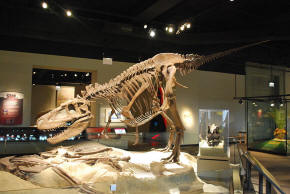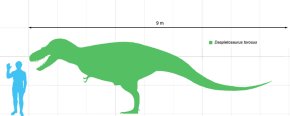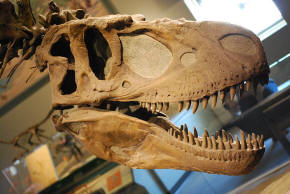|
As an
apex predator,
Daspletosaurus was at the top of the
food
chain, probably preying on large dinosaurs like the
ceratopsid
Centrosaurus and the
hadrosaur
Hypacrosaurus. In some areas,
Daspletosaurus coexisted with
another tyrannosaurid,
Gorgosaurus, though there is some evidence of
niche differentiation between the two. While
Daspletosaurus
fossils are rarer than other tyrannosaurids, the available specimens allow
some analysis of the biology of these animals, including
social behavior, diet and life history.
Description
While very large by the standard of
modern predators, Daspletosaurus
was not the largest tyrannosaurid. Adults could reach a length of 8–9 meters
(26–30 ft) from snout to tail. Mass estimates
have centered around 2.5 tonnes
(2.75 short
tons) but have ranged between 1.8 tonnes
(2 tons) and 3.8 tonnes (4.1 tons).
Daspletosaurus
had a massive skull that could reach more than 1 meter (3.3 ft) in length.
The bones were heavily constructed and some, including the nasal bones on top of
the snout, were fused for strength. Large
fenestrae (openings) in
the skull reduced its weight. An adult
Daspletosaurus was armed with about six dozen
teeth that were very long but oval in cross section rather
than blade-like. The
orbit (eye socket) was
a tall oval, somewhere in between the circular shape seen in
Gorgosaurus and the
'keyhole' shape of Tyrannosaurus.
Daspletosaurus
shared the same body form as other tyrannosaurids, with a short,
S-shaped neck supporting
the massive skull. It walked on its two thick hindlimbs, which ended in
four-toed feet, although the first digit (the
hallux) did not contact
the ground. In contrast, the forelimbs were extremely small and bore only
two digits, although Daspletosaurus
had the longest forelimbs in proportion to body size of any tyrannosaurid. A
long, heavy tail served as a counterweight to the
head and torso, with the center of gravity over
the hips.
Classification and
systematics
Daspletosaurus
belongs in the subfamily Tyrannosaurinae within the
family
Tyrannosauridae, along
with
Tarbosaurus,
Tyrannosaurus and
Alioramus. Animals in
this subfamily are more closely related to
Tyrannosaurus than to
Albertosaurus and are
known — with the exception of Alioramus
— for their robust build with proportionally larger skulls and longer
femora than in the
other subfamily, the Albertosaurinae.
Daspletosaurus
is usually considered to be closely related to
Tyrannosaurus rex, or even a direct ancestor
through
anagenesis.
Gregory Paul reassigned
D. torosus to the
genus Tyrannosaurus,
creating the new combination Tyrannosaurus
torosus, but this has not been generally
accepted. Many researchers believe
Tarbosaurus and
Tyrannosaurus to be
sister taxa or even to
be the same genus, with Daspletosaurus
a more
basal relative.
On the other hand,
Phil Currie and
colleagues find Daspletosaurus
to be more closely related to Tarbosaurus
and other
Asian tyrannosaurids
like Alioramus than
to the North American Tyrannosaurus.
The
systematics (evolutionary
relationships) of Daspletosaurus
may become clearer once all the species have been described.
Discovery and Naming
The
type specimen of
Daspletosaurus torosus (CMN
8506) is a partial skeleton including the skull, the shoulder, a forelimb,
the pelvis, a femur and all
of the vertebrae from the
neck, torso and hip, as well as the first eleven tail vertebrae. It was
discovered in 1921 by
Charles Mortram Sternberg,
who thought it was a new species of Gorgosaurus.
It was not until 1970 that the specimen was fully described by
Dale Russell, who made
it the type of a new genus, Daspletosaurus,
from the Greek stems
δασπλητo-/daspleto-
('frightful') and σαυρος/sauros
('lizard'). The type species is
D. torosus, which is
Latin for 'muscular' or
'brawny.' Aside from the type, there is only one other well-known specimen,
a complete skeleton discovered in 2001. Both specimens were recovered from
the
Oldman
Formation in the
Judith River Group of
Alberta. A specimen from the younger
Horseshoe Canyon Formation
in Alberta has been reassigned to Albertosaurus
sarcophagus. The Oldman Formation was deposited
during the middle
Campanian
stage of the
Late Cretaceous, from
about 77 to 76 Ma (million years ago).
Unnamed Species
Two or three additional species have
been assigned to the genus Daspletosaurus
over the years, although as of 2007 none of these species have received a
proper description or
scientific name. In the
meantime, all are assigned to Daspletosaurus
sp. although this does not imply that they all are the same species.
Along with the
holotype, Russell
designated a specimen collected by
Barnum Brown in
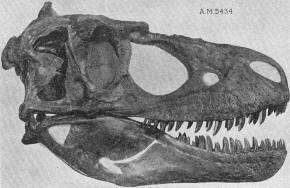 |
|
Originally believed to be a
specimen of Gorgosaurus libratus
this skull (AMNH 5434) was later sold to the Field Museum in Chicago
and is now exhibited as FMNH PR308. The specimen was later
reassigned to Daspletosaurus torosus
by Thomas Carr in 1999.Originally believed to be a specimen of
Gorgosaurus libratus this skull (AMNH 5434) was later sold to the
Field Museum in Chicago and is now exhibited as FMNH PR308. The
specimen was later reassigned to Daspletosaurus torosus by Thomas
Carr in 1999.
|
1913 as
the
paratype of
D. torosus. This specimen
(AMNH
5438) consists of parts of the hindleg, the pelvis and some of its
associated vertebrae. It was discovered in the upper part of the Oldman
Formation in Alberta. This upper section has since been renamed the
Dinosaur Park Formation,
which dates back to the middle Campanian, from 76–74 Ma (million years ago).
In 1914, Brown collected a nearly complete skeleton and skull; forty years
later his
American Museum of Natural History
sold this specimen to the
Field Museum of Natural History
in Chicago. It was mounted
for display in Chicago and labeled as
Albertosaurus libratus for many years, but after
several skull features were later found to be modeled in plaster, including
most of the teeth, the specimen (FMNH
PR308) was reassigned to Daspletosaurus.
A total of eight specimens have been collected from the Dinosaur Park
Formation over the years since, most of them within the boundaries of
Dinosaur Provincial Park.
Phil Currie believes that the Dinosaur Park specimens represent a new
species of Daspletosaurus,
distinguished by certain features of the skull. Pictures of this new species
have been published, but it still awaits a name and full description in
print.
A new tyrannosaur specimen (OMNH
10131), including skull fragments, ribs and parts of the hindlimb, was
reported from New Mexico in 1990 and assigned to the now-defunct genus
Aublysodon. Many later
authors have reassigned this specimen, along with a few others from New
Mexico, to yet another unnamed species of
Daspletosaurus. However, research published in
2010 showed that this species, from the Hunter Wash Member of the
Kirtland Formation, is
actually a more primitive tyrannosauroid, and was classified in the genus
Bistahieversor. There
is currently disagreement over the age of the Kirtland Formation, with some
workers claiming a late Campanian age, while others suggest a younger age in
the early
Maastrichtian stage.
In 1992,
Jack Horner and
colleagues published an extremely preliminary report of a tyrannosaurid from
the upper parts of the Campanian
Two Medicine Formation
in Montana, which was interpreted as a transitional species between
Daspletosaurus and the
later Tyrannosaurus.
Another partial skeleton was reported from the Upper Two Medicine in 2001,
preserving the remains of a juvenile hadrosaur in its abdominal cavity. This
specimen was assigned to
Daspletosaurus
but not to any particular species. The remains of at least three more
Daspletosaurus have also
been described in a Two Medicine
bonebed. These
specimens have not been described in detail, but Currie believes all of the
Two Medicine material represents an as-yet-unnamed third species of
Daspletosaurus.
Paleobiology
Coexistence with Gorgosaurus
In the late Campanian of North
America, Daspletosaurus
was a contemporary of the albertosaurine tyrannosaurid
Gorgosaurus. This is one
of the few examples of two tyrannosaur genera coexisting. In modern predator
guilds, similar-sized
predators are separated into different
ecological niches by
anatomical, behavioral or geographical differences that limit competition.
Several studies have attempted to explain niche differentiation in
Daspletosaurus and
Gorgosaurus.
Dale Russell hypothesized that the
more lightly built and more common Gorgosaurus
may have preyed on the abundant hadrosaurs of the time, while the more
robust and less common Daspletosaurus
may have specialized on the less prevalent but better-defended ceratopsids,
which may have been more difficult to hunt. However, a specimen of
Daspletosaurus (OTM 200)
from the Two Medicine Formation preserves the digested remains of a juvenile
hadrosaur in its gut region. The higher and broader muzzles of
tyrannosaurines like Daspletosaurus
are mechanically stronger than the lower snouts of albertosaurines like
Gorgosaurus,
although tooth strengths are similar between the two groups. This may
indicate a difference in feeding mechanics or diet.
Other authors have suggested that
competition was limited by geographical separation. Unlike some other groups
of dinosaurs, there appears to be no correlation with distance from the sea.
Neither Daspletosaurus
nor Gorgosaurus was
more common at higher or lower elevations than the other. However, while
there is some overlap, Gorgosaurus
appears to be more common at northern latitudes, with species of
Daspletosaurus more
abundant to the south. The same pattern is seen in other groups of
dinosaurs. Chasmosaurine ceratopsians and hadrosaurine hadrosaurs are also
more common in the Two Medicine Formation and in southwestern North America
during the Campanian.
Thomas Holtz has
suggested that this pattern indicates shared ecological preferences between
tyrannosaurines, chasmosaurines and hadrosaurines. Holtz notes that, at the
end of the later
Maastrichtian stage,
tyrannosaurines like Tyrannosaurus rex,
hadrosaurines and chasmosaurines like
Triceratops were
widespread throughout western North America, while albertosaurines and
centrosaurines went extinct, and lambeosaurines were very rare.
Social Behavior
A young specimen of the Dinosaur
Park Daspletosaurus
species (TMP
94.143.1) shows bite marks on the face that were inflicted by another
tyrannosaur. The bite marks are healed over, indicating that the animal
survived the bite. A full-grown Dinosaur Park
Daspletosaurus (TMP 85.62.1) also exhibits
tyrannosaur bite marks, showing that attacks to the face were not limited to
younger animals. While it is possible that the bites were attributable to
other species, intraspecific aggression, including facial biting, is very
common among predators. Facial bites are seen in other tyrannosaurs like
Gorgosaurus and
Tyrannosaurus, as
well as in other theropod genera like
Sinraptor and
Saurornitholestes.
Darren Tanke and Phil
Currie hypothesize that the bites are due to
intraspecific competition
for territory or resources, or for dominance within a social group.
Evidence that
Daspletosaurus lived in
social groups comes from a bonebed found in the Two Medicine Formation of
Montana. The bonebed includes the remains of three
Daspletosaurus, including
a large adult, a small juvenile, and another individual of intermediate
size. At least five hadrosaurs are preserved at the same location. Geologic
evidence indicates that the remains were not brought together by river currents but that
all of the animals were buried simultaneously at the same location. The
hadrosaur remains are scattered and bear numerous marks from tyrannosaur
teeth, indicating that the
Daspletosaurus
were feeding on the hadrosaurs at the time of death. The cause of death is
unknown. Currie speculates that the daspletosaurs formed a pack, although this
cannot be stated with certainty. Other scientists are skeptical of the
evidence for social groups in
Daspletosaurus
and other large theropods; Brian Roach and Daniel Brinkman have suggested
that Daspletosaurus
social interaction would have more closely resembled the modern Komodo dragon, where
non-cooperative individuals mob carcasses, frequently attacking and even
cannibalizing each
other in the process.
Life History
Paleontologist Gregory Erickson and
colleagues have studied the growth and life history of
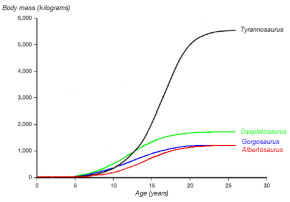 |
| A graph showing the hypothesized growth curves (body mass versus
age) of four tyrannosaurids. Daspletosaurus is shown in green. |
tyrannosaurids.
Analysis of bone
histology can determine
the age of a specimen when it died. Growth rates can be examined when the
age of various individuals are plotted against their size on a graph.
Erickson has shown that after a long time as juveniles, tyrannosaurs
underwent tremendous growth spurts for about four years midway through their
lives. After the rapid growth phase ended with
sexual maturity, growth
slowed down considerably in adult animals. Erickson only examined
Daspletosaurus from the
Dinosaur Park Formation, but these specimens show the same pattern. Compared
to albertosaurines, Daspletosaurus
showed a faster growth rate during the rapid growth period due to its higher
adult weight. The maximum growth rate in
Daspletosaurus was 180 kilograms (400 lb)
per year, based on a mass estimate of 1800 kilograms (2 tons) in adults.
Other authors have suggested higher adult weights for
Daspletosaurus; this would
change the magnitude of the growth rate but not the overall pattern.
Paleoecology
All known
Daspletosaurus fossils
have been found in formations dating to the middle to late Campanian stage
of the Late Cretaceous Period, between 77 and 74 million years ago. Since
the middle of the Cretaceous, North America had been divided in half by the
Western Interior Seaway,
with much of Montana and Alberta below the surface. However, the uplift of
the Rocky Mountains in the
Laramide Orogeny to the
west, which began during the time of
Daspletosaurus, forced the seaway to retreat
eastwards and southwards. Rivers flowed down from the mountains and drained
into the seaway, carrying sediment along with them that formed the Two
Medicine Formation, the Judith River Group, and other
sedimentary formations
in the region. About 73 million years ago, the seaway began to advance
westwards and northwards again, and the entire region was covered by the
Bearpaw Sea, represented throughout the western United States and Canada by
the massive
Bearpaw Shale.
Daspletosaurus
lived in a vast floodplain along the western shore of the interior seaway.
Large rivers watered the land, occasionally flooding and blanketing the
region with new sediment. When water was plentiful, the region could support
a great deal of plant and animal life, but periodic droughts also struck the
region, resulting in mass mortality as preserved in the many bonebed
deposits found in Two Medicine and Judith River sediments, including the
Daspletosaurus
bonebed. Similar conditions exist today in East Africa. Volcanic eruptions from
the west periodically blanketed the region with ash, also resulting in
large-scale mortality, while simultaneously enriching the soil for future
plant growth. It is these ash beds that allow precise radiometric dating as
well. Fluctuating sea levels also resulted in a variety of other
environments at different times and places within the Judith River Group,
including offshore and nearshore marine habitats, coastal wetlands, deltas
and lagoons, in addition to the inland floodplains. The Two Medicine
Formation was deposited at higher elevations farther inland than the other
two formations.
The excellent vertebrate fossil
record of Two Medicine and Judith River rocks resulted
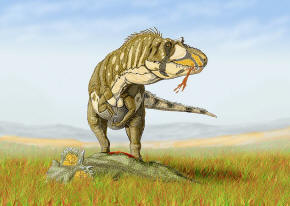 |
| Artwork of a Daspletosaurus torosus feeding on a ceratopsian (Picture
Source) |
from a combination of
abundant animal life, periodic natural disasters, and the deposition of
large amounts of sediment. Many types of freshwater and
estuarine fish are
represented, including sharks, rays, sturgeons,
gars and others. The Judith River Group
preserves the remains of many aquatic amphibians and reptiles, including
frogs, salamanders, turtles,
Champsosaurus and
crocodilians.
Terrestrial lizards, including
whiptails,
skinks,
monitors and
alligator lizards have
also been discovered.
Azhdarchid
pterosaurs, and
neornithean birds like
Apatornis flew
overhead, while the
enantiornithiform bird
Avisaurus and several
varieties of
multituberculate,
marsupial and placental
mammals scurried
beneath the feet of Daspletosaurus
and other dinosaurs.
In the Oldman Formation,
Daspletosaurus torosus
could have preyed upon hadrosaurs like
Brachylophosaurus and
Hypacrosaurus, small
ornithopods like
Orodromeus,
ceratopsians like
Centrosaurus,
pachycephalosaurs,
ornithomimids,
therizinosaurs and
possibly ankylosaurs. Other
predators included
troodonts,
oviraptorosaurs, the
dromaeosaur
Saurornitholestes and
possibly an albertosaurine tyrannosaur (genus currently unknown). The
Dinosaur Park and Two Medicine Formations have
faunas comparable to
the Oldman, with the Dinosaur Park in particular preserving an unrivaled
array of dinosaurs. The albertosaurine
Gorgosaurus lived alongside species of
Daspletosaurus in the
Dinosaur Park and Upper Two Medicine environments. Young tyrannosaurs may
have filled the niches in between adult tyrannosaurs and smaller theropods,
which were separated by two orders of magnitude in mass.
Return to the
Old Earth Ministries Online Dinosaur
Curriculum homepage.

Shopping
|
